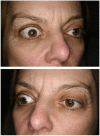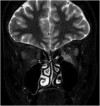McKittrick-Wheelock syndrome presenting with presumed paraneoplastic syndrome extra-ocular muscle enlargement masquerading as thyroid eye disease
- PMID: 37341464
- PMCID: PMC10337438
- DOI: 10.1530/EDM-22-0386
McKittrick-Wheelock syndrome presenting with presumed paraneoplastic syndrome extra-ocular muscle enlargement masquerading as thyroid eye disease
Abstract
Summary: Paraneoplastic syndromes (PS) are uncommon and are known to mimic other clinical entities, often carrying significant morbidity and mortality. The commonest cause of extra-ocular muscle enlargement (EOME) is thyroid eye disease (TED). Rarely, PS can cause EOME and masquerade as TED. We describe a 52-year-old female who presented with diarrhoea, acute kidney injury and electrolyte imbalance. An ophthalmic review identified right upper lid retraction. MRI orbits showed increased thickness of the inferior and medial recti bilaterally, presumed as TED. Whilst investigating her diarrhoea, imaging revealed a large rectosigmoid tumour which required surgical excision. In the context of electrolyte disturbance and acute kidney injury, a diagnosis of McKittrick-Wheelock syndrome (MWS) was made. Following successful surgery, electrolyte imbalance, diarrhoea and eyelid retraction improved. Repeat MRI orbits displayed complete resolution of EOME. To our knowledge, this is the first case of MWS presenting with PS-EOME masquerading as TED.
Learning points: McKittrick-Wheelock syndrome (MWS) is a rare disorder, although likely under-recognised, which is characterised by diarrhoea, dehydration and electrolyte depletion that results from a hypersecretory colorectal neoplasm. Definitive treatment of MWS involves the resection of the colorectal neoplasm. Bilateral ophthalmopathy that appears to be Graves' ophthalmopathy on imaging, though clinical and biochemical evidence fails to identify a thyroid pathology, has been associated with malignancy on rare occasions. Such patients should be investigated for potential malignant causes of their ophthalmopathy.
Conflict of interest statement
The authors declare that there is no conflict of interest that could be perceived as prejudicing the impartiality of the research reported.
Figures



References
LinkOut - more resources
Full Text Sources

